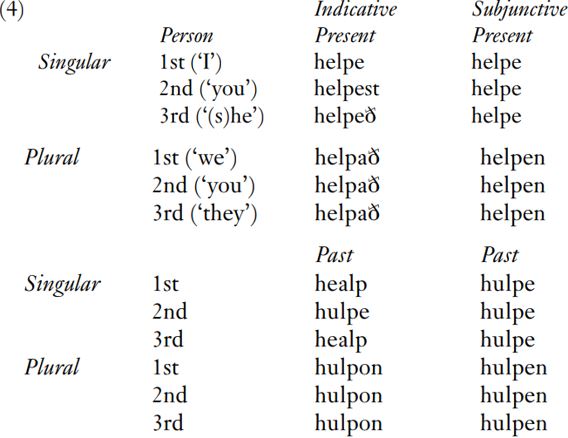


 Grammar
Grammar
 Tenses
Tenses
 Present
Present
 Past
Past
 Future
Future
 Parts Of Speech
Parts Of Speech
 Nouns
Nouns
 Verbs
Verbs
 Adverbs
Adverbs
 Adjectives
Adjectives
 Pronouns
Pronouns
 Pre Position
Pre Position
 Preposition by function
Preposition by function 
 Preposition by construction
Preposition by construction
 Conjunctions
Conjunctions
 Interjections
Interjections
 Grammar Rules
Grammar Rules
 Linguistics
Linguistics
 Semantics
Semantics
 Pragmatics
Pragmatics
 Reading Comprehension
Reading Comprehension|
Read More
Date: 15-1-2022
Date: 2023-10-11
Date: 2023-10-02
|
We noted that modern English nouns have no more than two inflected word forms: singular and plural. In Old English, however, there was superimposed on this number contrast a contrast of case, like that found in modern English personal pronouns (nominative we versus accusative us etc.), but more extensive: Old English nouns could distinguish also a genitive (or possessive) case, and a dative case whose meanings included that of modern to in Mary gave the book to John. These two numbers and four cases yielded a pattern of eight grammatical words for each noun lexeme, as illustrated at (2) and (3):


As will be seen, neither NAMA nor  had eight distinct word forms, one for each grammatical word; instead, they display different patterns of syncretism. However, all Old English nouns had more than the meager two forms that are available in modern English.
had eight distinct word forms, one for each grammatical word; instead, they display different patterns of syncretism. However, all Old English nouns had more than the meager two forms that are available in modern English.
If nouns distinguished four cases in Old English, it is reasonable to guess that pronouns should have done so too; and that guess is correct. (In fact Old English pronouns sometimes had five cases, including an instrumental.) What is more, the same two numbers and four cases were available for adjectives and determiners (counterparts of words such as that and this), along with a distinction that has been lost in modern English: that of gender. As in modern German or Russian, Old English nouns were distributed among three genders (neuter, feminine and masculine), which were grammatically relevant in that they affected the inflectional affixes chosen by any adjectives and determiners that modified them. Thus, it is the distinction between masculine and feminine that accounts for the different forms of the words meaning ‘the’ and ‘good’ in  ‘the good father’ and
‘the good father’ and  ‘the good mother’.
‘the good mother’.
Old English verbs displayed a similar inflectional luxuriance. We noted that most modern English verbs have four distinct forms (e.g. perform, performs, performed, performing), while some common verbs have five (e.g. speak, speaks, spoke, spoken, speaking). By contrast, the typical Old English verb lexeme HELPAN ‘help’ had over a dozen distinct forms: a so-called ‘infinitive’ helpan ‘to help’, a perfective participle geholpen, and further forms including those whose grammatical functions are as set out in (4). (In (4), ´ stands for the sound represented by th in thin, and ‘indicative’ and ‘subjunctive’ represent a contast in mood: between, very roughly, asserting a fact (e.g. John is coming) and alluding to a possibility (e.g. … that John should come in I insist that John should come).)

Not included in (4) are the imperative forms (‘help!’), or the verbal adjective helpende, which, just like other adjectives in Old English, had forms that distinguished three genders, two numbers and four cases.
An obvious question is: why did English lose this wealth of inflection? Like many obvious questions, this one has no straightforward answer. Partly, no doubt, the loss of inflection is due to the temporary eclipse of English by French as the language of culture and administration after 1066, and hence the weakening of the conservative influence of literacy. Partly also it is due to dialect mixture. The examples of ‘Old English’ that I have given here come from the dominant dialect of written literature, that of south-western England. But this was not the dialect of London, which became increasingly influential during the so-called ‘Middle English’ period (from about 1150 to 1500), and established itself as the main variety used in printing. For example, the spread of the noun plural suffix -s at the expense of its rivals is a feature of northern dialects that affected the London dialect also. English inflectional morphology was already by 1600 almost the same as in 2000, so that modern readers of Shakespeare encounter only a few obsolete inflected forms such as thou helpest and he helpeth, for you help and he helps, that preserve two Old English suffixes illustrated in (2).
|
|
|
|
5 علامات تحذيرية قد تدل على "مشكل خطير" في الكبد
|
|
|
|
|
|
|
لحماية التراث الوطني.. العتبة العباسية تعلن عن ترميم أكثر من 200 وثيقة خلال عام 2024
|
|
|